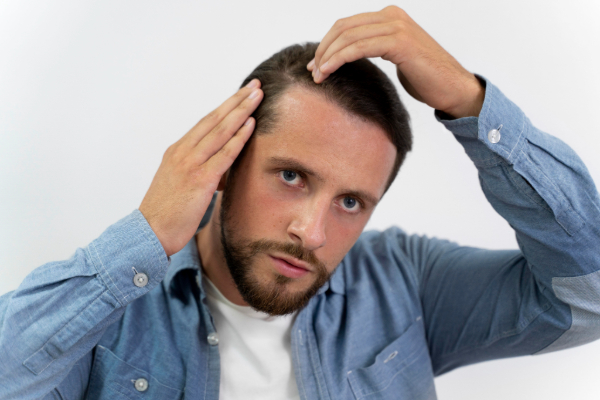05 June 2025
Understanding Male Hair Loss: Causes, Facts & What’s Normal
Hair loss can feel like a sensitive topic—but it’s far more common than most people realise. Whether you’ve just started noticing changes or have been watching your hair thin gradually over the years, know this: you’re not alone, and there’s plenty you can do to understand and manage it.
At Hove Hair Clinic, we’ve supported many men through their hair loss journey—and it often starts with one thing: understanding why it’s happening.
Why Does Male Hair Loss Happen?
Here are the most common causes:
1. Genetics (Androgenetic Alopecia)
Also known as male pattern baldness, this is by far the most common cause of hair loss in men. If your father, uncles, or grandfathers experienced thinning or baldness, there’s a good chance you might too. It usually shows up as a receding hairline or thinning at the crown—and often progresses over time.
2. Hormonal Changes: DHT Sensitivity
Dihydrotestosterone (DHT) is a hormone derived from testosterone. In those genetically predisposed, DHT binds to hair follicles and causes them to shrink. Over time, this means thinner strands, slower regrowth, and eventually, dormant follicles that stop producing hair altogether.
3. Lifestyle Factors
Stress, poor sleep, and inadequate nutrition can all play a role in accelerating hair loss. Your hair is a reflection of your overall health, so lifestyle habits really do matter. High stress levels, crash diets, or nutrient deficiencies can disrupt the hair growth cycle and lead to increased shedding.
4. Underlying Health Conditions
Issues like thyroid disorders, iron deficiency, or autoimmune conditions (such as alopecia areata) can interfere with healthy hair growth. If your hair loss feels sudden or extreme, it’s worth speaking to a health professional to rule out any underlying causes.
5. Scalp Conditions
A healthy scalp is essential for healthy hair. Conditions like dandruff, seborrhoeic dermatitis, or scalp psoriasis can inflame the skin and weaken the follicles. If left untreated, these issues may worsen hair loss and prevent healthy regrowth.
How Much Hair Loss is Normal?
It’s completely normal to shed between 50 and 100 hairs a day—this is just part of your hair’s natural life cycle. But how do you know when it’s more than that?
Signs that may indicate a problem include:
Clumps of hair falling out during washing or brushing
Increased hair on your pillow, clothes, or shower drain
Noticeable thinning or scalp visibility where there used to be coverage
If you’ve noticed these changes, it may be time to take a closer look at what’s happening—and explore your options.
When Does Male Hair Loss Usually Start?
Hair loss can begin at any age, but here’s what we typically see:
In your 20s or 30s: The most common window when men start to notice gradual thinning or a receding hairline
Teens: Less common, but still possible—especially with a strong genetic link
Initial signs: Thinning at the crown, less hair volume, a more visible scalp, or that familiar “M-shaped” hairline
The earlier you notice the signs, the better positioned you are to act.
Knowledge is Power (and Confidence)
Hair loss can feel overwhelming, but understanding the reasons behind it can help take some of the fear and frustration out of the process. Whether it’s hormonal, hereditary, or lifestyle-related, there are things you can do—and the earlier you act, the more options you may have.
We’ll be diving into Part 2 of this series soon, where we’ll share expert tips on stopping, preventing and reversing hair loss.
If you’re looking for more personalised advice or professional hair and scalp treatments, reach out to us at Hove Hair Clinic on 01273 711140. We’re here to help you achieve your goals with expert guidance and bespoke care.
Take care of yourself—and your hair.
And if you’ve got questions in the meantime, we’re always here to help.
Warm regards,
Sarah & The Hove Hair Clinic Team
